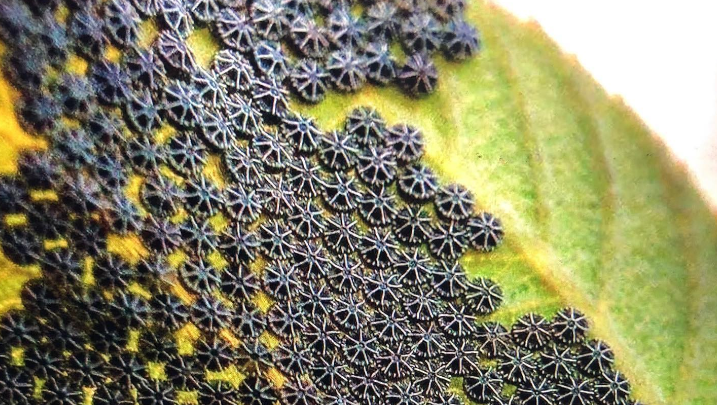You can always find me in my yard, I’m an avid gardener. Seeing the fruits of my labor and watching plants grow is incredibly satisfying, but let’s admit, it’s not without its challenges. Dealing with pests, especially, can be quite daunting. Sometimes, it’s hard to distinguish between helpful insects and those that can wreak havoc on all your hard work.
Recently, a picture circulated on social media that perfectly captured this dilemma. It was a close-up of a leaf adorned with intricate, tiny black geometric patterns. At first glance, it looked like the leaf was covered in an alien-like lattice or some peculiar disease. Like many others, I was intrigued and somewhat alarmed by it.

Upon investigation, I discovered that these intricate patterns were actually the eggs of Nymphalis antiopa butterflies. If you’re unfamiliar, let me introduce you to this fascinating species. The Mourning Cloak butterfly, Nymphalis antiopa, has a unique life cycle and some remarkable traits.
Let’s start with the eggs. The close-up image showed clusters of eggs resembling delicate black lace delicately laid on the leaf’s surface. Once you get past the initial surprise, they’re quite beautiful, a marvel of precise geometry. My first thought upon seeing them was: “This could either be very good or very bad for my garden”.
Luckily, there’s good news: Nymphalis antiopa butterflies serve several beneficial purposes. While their caterpillars feed on leaves, they tend to prefer willows, elms, and poplars, among other trees and shrubs. So, if your garden is brimming with vegetables and flowers, you should be relatively safe. Additionally, these butterflies also feed on decaying fruit, aiding in decomposition, which can be beneficial in your garden ecosystem.

Watching these butterflies go through their life cycle is truly fascinating. The caterpillars hatch from these intricate eggs, bristly, spiky creatures with black bodies adorned with tiny white dots. They go through several growth stages known as instars, shedding their skin as they grow larger.
When they mature, the caterpillars find a secure spot to pupate, encasing themselves in a chrysalis that resembles a miniature sleeping bag. Depending on environmental conditions, this stage can last from a few weeks to several months. Upon emerging, they transform into the striking Mourning Cloak butterflies, distinguished by dark velvety wings accented with blue and bordered by a vibrant yellow edge.
One of the most intriguing aspects of Mourning Cloak butterflies is their behavior. Unlike many other species, they hibernate during winter, seeking refuge under old sheds, loose bark, or even piles of wood. They are among the first butterflies to appear in spring, often before flowers begin to bloom. Their name, “Mourning Cloaks”, partly stems from their early emergence, contrasting starkly with the still-bare early spring landscape, their dark, melancholy wings resembling a mourning cloak.

As gardeners, we often focus on how insects immediately impact our plants. The sight of caterpillars can provoke fears of widespread damage. However, it’s crucial to step back and consider the bigger picture. Nymphalis antiopa butterflies provide a perfect example of how nature achieves balance. While their caterpillars may consume some leaves, they won’t decimate your garden. In fact, by hosting these butterflies, you’re enhancing your garden’s biodiversity.
So, what should you do if you encounter these caterpillars or eggs in your garden? My advice: observe and appreciate the process. If you’re concerned about your plants, gently relocate the caterpillars to a nearby tree or shrub where they can thrive without posing a threat to your prized blooms.

Gardening is all about balance, harmonizing with the creatures that share your space and the plants you cherish. Next time you spot something unusual in your garden, take a moment to investigate before reaching for pesticides. Just like my encounter with Nymphalis antiopa butterfly eggs, you might uncover something truly extraordinary. Ultimately, every season in the garden is an adventure. Embrace the challenges and rewards, they’re what make gardening so fulfilling.
